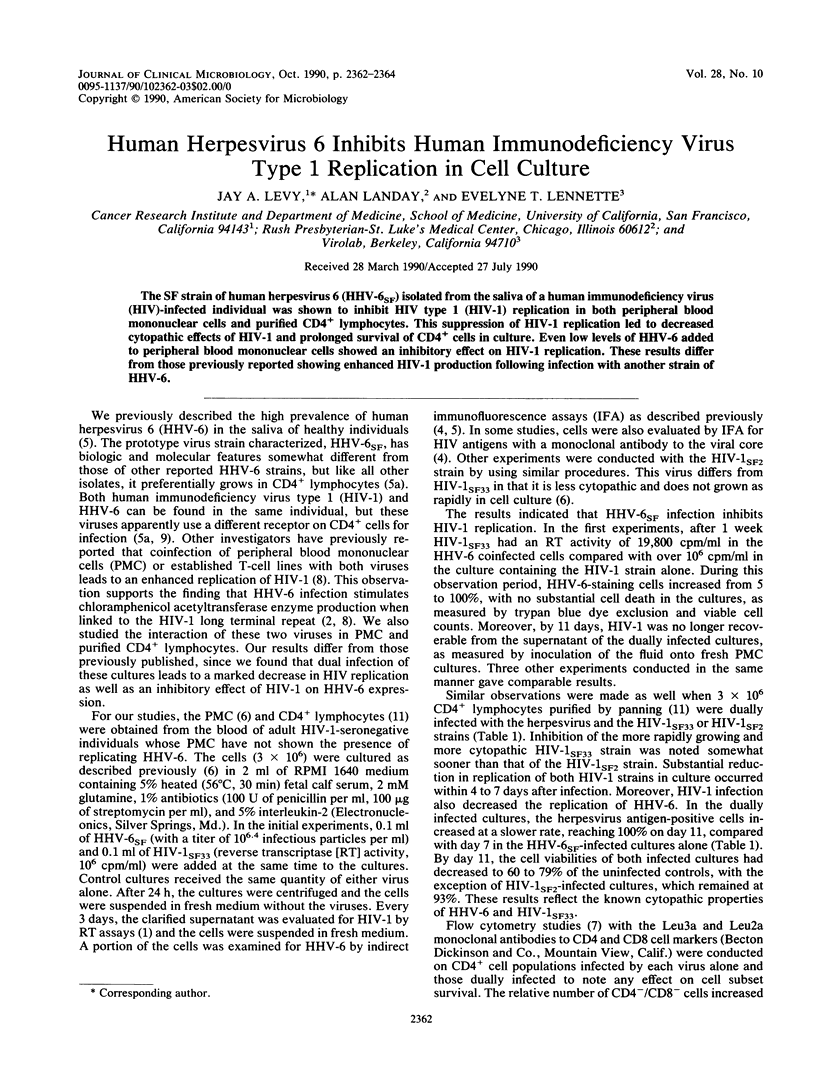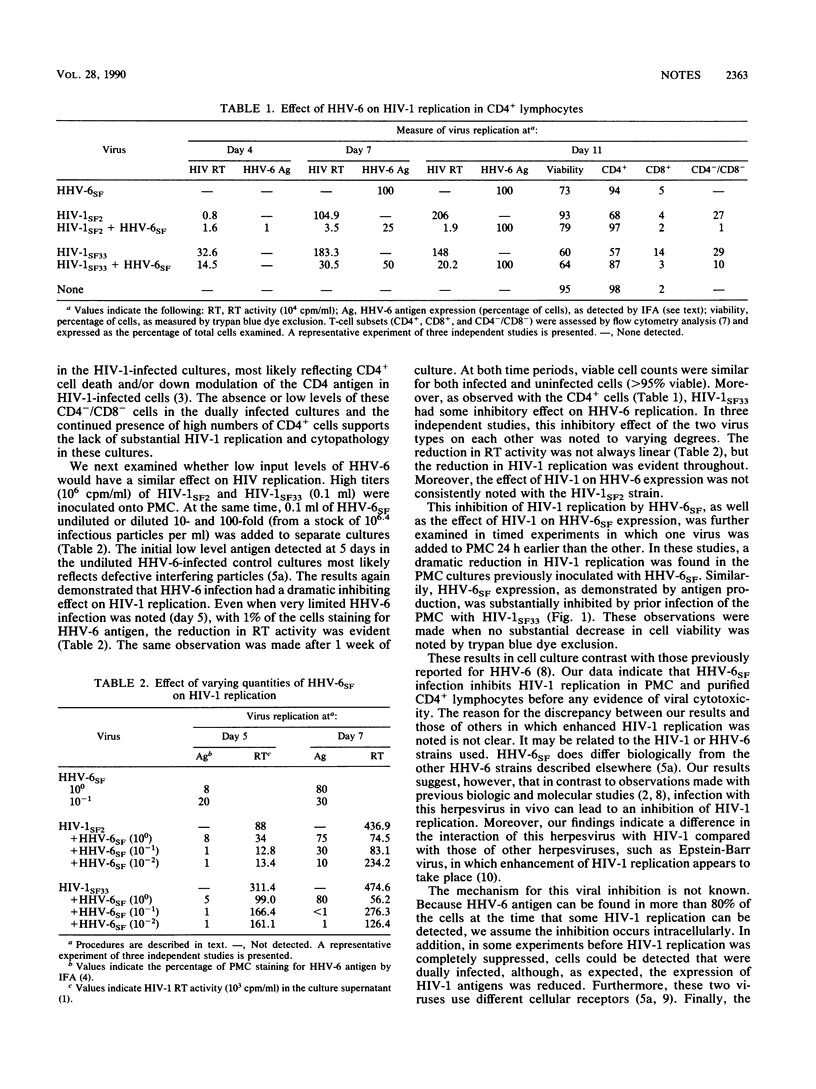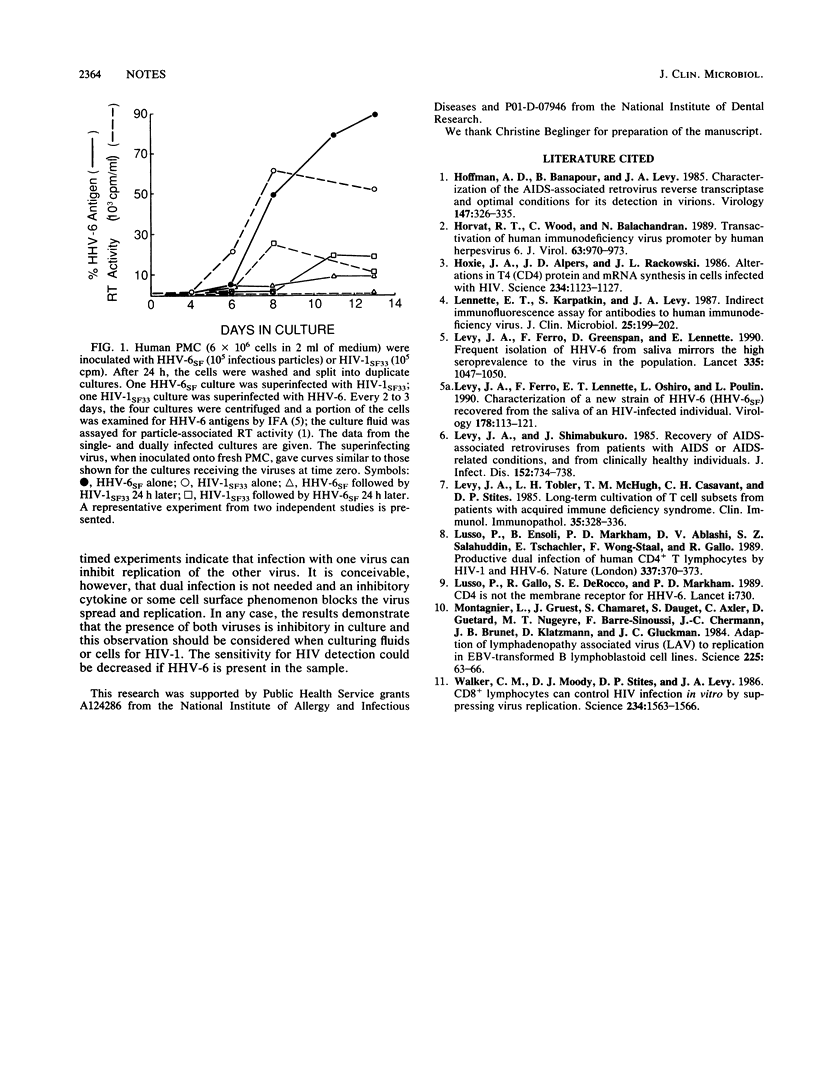Abstract
The SF strain of human herpesvirus 6 (HHV-6SF) isolated from the saliva of a human immunodeficiency virus (HIV)-infected individual was shown to inhibit HIV type 1 (HIV-1) replication in both peripheral blood mononuclear cells and purified CD4+ lymphocytes. This suppression of HIV-1 replication led to decreased cytopathic effects of HIV-1 and prolonged survival of CD4+ cells in culture. Even low levels of HHV-6 added to peripheral blood mononuclear cells showed an inhibitory effect on HIV-1 replication. These results differ from those previously reported showing enhanced HIV-1 production following infection with another strain of HHV-6.
Full text
PDF


Selected References
These references are in PubMed. This may not be the complete list of references from this article.
- Hoffman A. D., Banapour B., Levy J. A. Characterization of the AIDS-associated retrovirus reverse transcriptase and optimal conditions for its detection in virions. Virology. 1985 Dec;147(2):326–335. doi: 10.1016/0042-6822(85)90135-7. [DOI] [PubMed] [Google Scholar]
- Horvat R. T., Wood C., Balachandran N. Transactivation of human immunodeficiency virus promoter by human herpesvirus 6. J Virol. 1989 Feb;63(2):970–973. doi: 10.1128/jvi.63.2.970-973.1989. [DOI] [PMC free article] [PubMed] [Google Scholar]
- Hoxie J. A., Alpers J. D., Rackowski J. L., Huebner K., Haggarty B. S., Cedarbaum A. J., Reed J. C. Alterations in T4 (CD4) protein and mRNA synthesis in cells infected with HIV. Science. 1986 Nov 28;234(4780):1123–1127. doi: 10.1126/science.3095925. [DOI] [PubMed] [Google Scholar]
- Lennette E. T., Karpatkin S., Levy J. A. Indirect immunofluorescence assay for antibodies to human immunodeficiency virus. J Clin Microbiol. 1987 Feb;25(2):199–202. doi: 10.1128/jcm.25.2.199-202.1987. [DOI] [PMC free article] [PubMed] [Google Scholar]
- Levy J. A., Ferro F., Greenspan D., Lennette E. T. Frequent isolation of HHV-6 from saliva and high seroprevalence of the virus in the population. Lancet. 1990 May 5;335(8697):1047–1050. doi: 10.1016/0140-6736(90)92628-u. [DOI] [PubMed] [Google Scholar]
- Levy J. A., Ferro F., Lennette E. T., Oshiro L., Poulin L. Characterization of a new strain of HHV-6 (HHV-6SF) recovered from the saliva of an HIV-infected individual. Virology. 1990 Sep;178(1):113–121. doi: 10.1016/0042-6822(90)90384-4. [DOI] [PubMed] [Google Scholar]
- Levy J. A., Shimabukuro J. Recovery of AIDS-associated retroviruses from patients with AIDS or AIDS-related conditions and from clinically healthy individuals. J Infect Dis. 1985 Oct;152(4):734–738. doi: 10.1093/infdis/152.4.734. [DOI] [PubMed] [Google Scholar]
- Levy J. A., Tobler L. H., McHugh T. M., Casavant C. H., Stites D. P. Long-term cultivation of T-cell subsets from patients with acquired immune deficiency syndrome. Clin Immunol Immunopathol. 1985 Jun;35(3):328–336. doi: 10.1016/0090-1229(85)90093-5. [DOI] [PubMed] [Google Scholar]
- Lusso P., Ensoli B., Markham P. D., Ablashi D. V., Salahuddin S. Z., Tschachler E., Wong-Staal F., Gallo R. C. Productive dual infection of human CD4+ T lymphocytes by HIV-1 and HHV-6. Nature. 1989 Jan 26;337(6205):370–373. doi: 10.1038/337370a0. [DOI] [PubMed] [Google Scholar]
- Lusso P., Gallo R. C., DeRocco S. E., Markham P. D. CD4 is not the membrane receptor for HHV-6. Lancet. 1989 Apr 1;1(8640):730–730. doi: 10.1016/s0140-6736(89)92249-6. [DOI] [PubMed] [Google Scholar]
- Montagnier L., Gruest J., Chamaret S., Dauguet C., Axler C., Guétard D., Nugeyre M. T., Barré-Sinoussi F., Chermann J. C., Brunet J. B. Adaptation of lymphadenopathy associated virus (LAV) to replication in EBV-transformed B lymphoblastoid cell lines. Science. 1984 Jul 6;225(4657):63–66. doi: 10.1126/science.6328661. [DOI] [PubMed] [Google Scholar]
- Walker C. M., Moody D. J., Stites D. P., Levy J. A. CD8+ lymphocytes can control HIV infection in vitro by suppressing virus replication. Science. 1986 Dec 19;234(4783):1563–1566. doi: 10.1126/science.2431484. [DOI] [PubMed] [Google Scholar]


